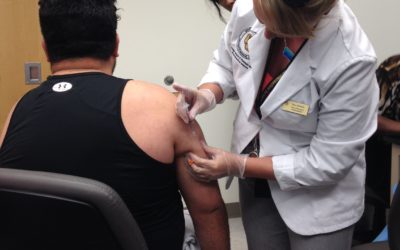Anaphylaxis is a severe and life-threatening condition that occurs when someone has an allergic reaction. Anaphylaxis can present itself as swelling of the throat or tongue, difficulty breathing (or fast breathing), tightness in the throat, weak pulse, skin rash, and/or nausea and vomiting.
The anaphylactic reaction is the result of a person’s exposure to an allergen including things like foods, insect bites, medications, or latex, most commonly. Anaphylaxis must be treated immediately with a shot of epinephrine. Often this shot comes in the form of an EpiPen. After administering an epinephrine shot, the person with anaphylaxis should go to the emergency room right away. If there is not an epinephrine shot available, someone with anaphylaxis should be taken to the emergency room immediately because anaphylaxis can be fatal.
What is epinephrine?
Epinephrine is a hormone medication also called adrenaline. It is something our bodies naturally produce to help us regulate our organ functions and tolerate stress to the body. When your body undergoes the “fight or flight” response, you may feel your heart racing and other heightened symptoms, this is because of the body releasing epinephrine. Epinephrine is the medication contained in the EpiPen. It is used to treat anaphylaxis primarily. However, there are some other uses for epinephrine in other medication forms as well. For instance, it can be used in the hospital to treat some heart conditions, and it has been used as an inhalation for people with asthma to open the airways. Until now, epinephrine has been available to people who have had anaphylaxis as an injection into the muscle with the EpiPen (or a generic version).
See our blog about Nasal Sprays for Seasonal Allergies
New Nasal Spray
In August of 2024, a new nasal spray containing epinephrine was approved by the FDA (U.S. Food and Drug Administration). The nasal spray is to be sold under the brand name neffy (epinephrine nasal spray). It was approved for emergency treatment of severe allergic reactions, including anaphylaxis, and can be used in adults and children who weigh 66 pounds or more. Neffy is administered as one spray in one nostril using a prefilled, single-use device containing 2mg of epinephrine. The manufacturer recommends keeping two neffy nasal spray devices on hand at all times. This is because a second dose may be administered into the same nostril with the second device if needed 5 minutes after the first dose.
This is an excellent new medication approval because it is the first epinephrine available for anaphylaxis that does not involve a needle. The neffy nasal spray device is also very easy to use. The manufacturer reports that 100% of adults and pediatric participants were able to administer neffy without error. It appears it is also intended to be available to people who need it at a more reasonable price than the epinephrine injection pen has been historically. The comparatively lower cost of the nasal spray may even help bring down the cost of the epinephrine injection pens, since there is now competition.
Disclaimer: This blog is written for informational and educational purposes only. It is not intended to be a substitute for professional medical advice, diagnosis, or treatment. Always seek the advice of your physician or other qualified health provider with any questions you may have regarding a medical condition. Never disregard professional medical advice or delay in seeking it because of something you have read or seen online.
Resources:
1) Manufacturer website: Neffy.com
2) Anaphylaxis information: https://www.aaaai.org/conditions-treatments/allergies/anaphylaxis












